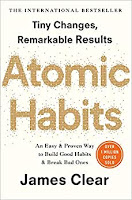Change Autopilot Direction with Atomic Habits
Atomic Habits
The author James clear wrote this great book called "Atomic Habits" where we explain how habits work and also how can we build habits(that we want). So whats is a habit, according to the author is "Habit = routine or behavior doing regularly almost automatic." IMHO this is the definition of our autopilot.
The book is full of interesting insights such as:
* The slow pace of transformation makes bad habits stick.
* Small habits that will payoff after lots of years.
* Overtime our small choices compound into bad results.
* You should be much more worried about your trajectory, not your results.
* You get what you repeat.
* Mastery requires patience.
* Results are much more about Systems(process) than Goals(Objectives).
* Goals are binary and put you in a narrow view of life.
* True behavior change is identity change.
* If you dont shift your belief behind the change will be hard.
* From Latin the definition: Identity == repeating being.
* Choose the best time to do the habit.
* We imitate the habits of the family.
* You need to fall in love with boredom.
The Habit Loop
It's a neurological loop that governs any habit. This loop is consistent with 4 elements(other authors might say is 3) which are:
* Cue: Are triggers where time is the biggest trigger of anything.
* Carving: Trigger make you look for the state that the reward provides.
* Response: Physical or mental action that occurs after the carving.
* Reward: It's the prize -- tells you brain - yeah the loop is awesome - let's keep doing this.
Other forms of Cue are:
* Location / Environment. e.g you going to the kitchen see cookies and you eat them.
* Preceding event. e.g After brunch my teeth start working.
* Emotional State. e.g feeling down and them eat some chocolates.
* Other people - Some studies show that one friend becomes obese your obsetity chances increase by 57% even by leaving hundreds of miles away.
The Compound Effect
Habits are about changing behavior
That's an interesting thing to think about it. Have you ever think that process might a form of habit and maybe with a different process == different habit == different behavior. I guess the difference between process and habits is that process is what people should do and habit is what happens in reality.
In order to change behavior with habits there are these 4 laws:
The Way Foward
We can classify our habits into 2 groups good and bad habits and they work to introduce new habits.
You also can remove bad habits by:
Habits are routines we do without thinking. We do good ones and bad ones. This is critical to archive self-improvement or even to get things done IMHO. Writing down your habits and reflect time is a great way to change yourself and improve.Cheers,
Diego Pacheco








